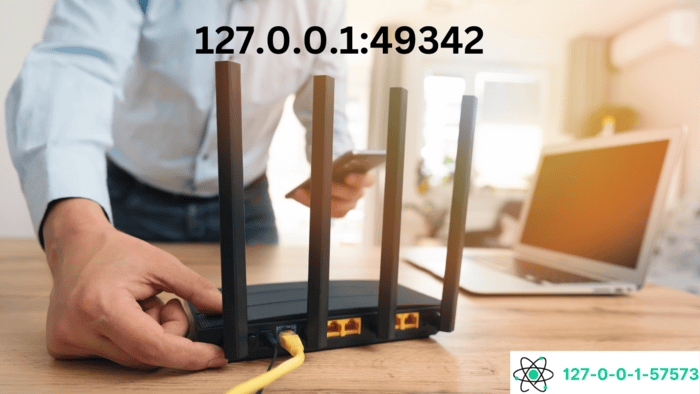In software development, localhost networking plays a crucial role in building, testing, and debugging applications without risking exposure to the public network.
By using addresses like 127.0.0.1 and ports such as 49342, developers can test their projects in a controlled environment. This article explains the concept behind the combination 127.0.0.1:49342 and how it benefits developers and IT professionals in various workflows.

What is 127.0.0.1:49342?
When a web developer works on a project, they often need a secure space to test the application before releasing it to the public. Instead of relying on an external server, they use 127.0.0.1:49342.
This combination of a local address and a port allows your machine to communicate with itself. Initially, it might seem technical, but it provides developers a safe and controlled environment to ensure their work is functioning correctly.
Breaking Down 127.0.0.1:49342
To better understand 127.0.0.1:49342, we must examine its components: the IP address 127.0.0.1 and the port number 49342.
The Localhost IP Address – 127.0.0.1
This is the “loopback” address, also called the localhost. It’s an address that allows a device to communicate with itself without connecting to an external server. This feature is extremely useful for developers to test applications on their local machine.
Port 49342 – A Temporary Communication Path
Port 49342 falls under the ephemeral port range (49152-65535). These ports are set aside for temporary communication needs, allowing several applications to use different ports without interference.
Using this range reduces the likelihood of port conflicts between multiple running applications. Together, 127.0.0.1:49342 enables developers to run isolated services on their computers, making development more efficient.
Common Uses of 127.0.0.1:49342
The combination of 127.0.0.1:49342 is widely used in different aspects of software development. Here are some common scenarios where it proves invaluable:
Web Development and Testing
Localhost setups like 127.0.0.1:49342 are heavily relied upon by developers working with servers like Apache, Nginx, or Node.js. They can test web applications, websites, and APIs without exposing them to the internet. Similarly, frameworks like Laravel or Flask also use localhost for development.
Database Development
When developers need to work with databases like MySQL or PostgreSQL, localhost allows them to quickly test connections, queries, and setups without needing to connect to an external server. This ensures a faster and more secure testing process.
Debugging Applications
Localhost environments allow developers to isolate their code from live systems. By running services locally, they can test and debug code changes without affecting any live applications. Port 49342 can be used to specify exact locations for requests and responses.
Working with Containers and Virtual Machines
Tools such as Docker use localhost networking to facilitate communication between containers. This ensures that different containers can interact with each other and perform tasks in isolation while remaining within the local development environment.
Testing Mobile Apps and IoT Devices
Developers can use localhost setups to simulate server interactions. This is especially helpful for testing mobile apps or Internet of Things (IoT) devices without needing an actual external server.

How 127.0.0.1:49342 Operates?
Understanding how 127.0.0.1:49342 works is simple. The process follows these basic steps:
- Local Server Starts: The server binds to 127.0.0.1 and listens on port 49342.
- Request from Application: Applications like web browsers send requests to 127.0.0.1:49342.
- Response from Server: The server processes the request and returns the necessary data.
This method keeps all interactions within the machine, ensuring the security of the development process.
Troubleshooting Issues with Localhost Setup
Working with 127.0.0.1:49342 can sometimes lead to a few common issues. Here’s how to deal with them:
Port Conflicts
If another application already uses port 49342, you can change to a different port in the ephemeral range. This will ensure no clashes with other running programs.
Firewall Restrictions
Sometimes, firewalls can block localhost ports. To resolve this, you may need to adjust firewall settings to allow communication on 127.0.0.1:49342.
Incorrect Server Configuration
Ensure the server is correctly set to listen to the address 127.0.0.1 and port 49342. A misconfigured server could prevent it from responding to requests.
To troubleshoot these issues, tools like netstat, lsof, or telnet can help identify port usage. Additionally, curl can be effective for testing the connection to a specific localhost address and port.
Best Practices for Working with 127.0.0.1:49342
To make sure you are using 127.0.0.1:49342 most effectively, consider these best practices:
- Select Random Ports: Always use ports in the range of 49152-65535 to minimize the risk of conflicts.
- Secure Your Firewall: Ensure your firewall allows local traffic while blocking unnecessary external connections.
- Encrypt Local Traffic: Whenever possible, use HTTPS even when working with localhost to build good security practices.
- Use Localhost for Development Only: Avoid using 127.0.0.1 setups for production environments.
- Update Your Tools: Regularly update your development software to fix security vulnerabilities.
Conclusion
127.0.0.1:49342 is a valuable tool in software development. It provides a safe and isolated space to build, test, and debug applications on a local machine.
Using this combination of address and port, developers can work without risking exposing their projects to external networks. Following best practices ensures a smooth and secure development process, making 127.0.0.1:49342 essential for developers and IT professionals.
